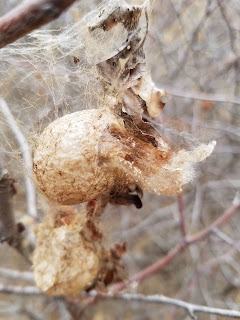 |
Here are three of them from the plums along the Creek Field:


But by the end of February, some were ripped open by predators:
So many eggs sacs had been preyed upon, I began to worry we wouldn't have beautiful black-and-yellow garden spiders in the summer.
The internal mesh had been dragged out....
...with little white things caught in it.
Were these egg shells left over from the spiders' hatching?
Or were they exoskeletons from an early molt?
Wanting to answer that question, I took some of the mesh home to put under a microscope. This is what it looked like magnified:
Meanwhile, my entomologist friend Dick Beeman confirmed that the white fragments are egg shells. Black-and-Yellow Garden Spiders hatch inside their egg sacs in the fall and do not feed or molt.
I marveled at the magnified textures in my lens, when, to my astonishment, some of the mesh started to move! More of it twitched, and then some of it started to crawl--by golly, on eight legs! Under magnification, the dragged out mesh was full of life!
This is what my phone recorded:
Following Dick's advice, I put them back in their damaged sac, back on their plum branch, to continue their march toward adulthood. Here they are, back outside:
Good luck, little guys! You are role models of resilience.
I look forward to seeing beautiful adult Black-and-Yellow Garden Spiders this summer. When I do, it will be with profound respect. Their road isn't easy and the ones who reach adulthood have traveled it well!





No comments:
Post a Comment